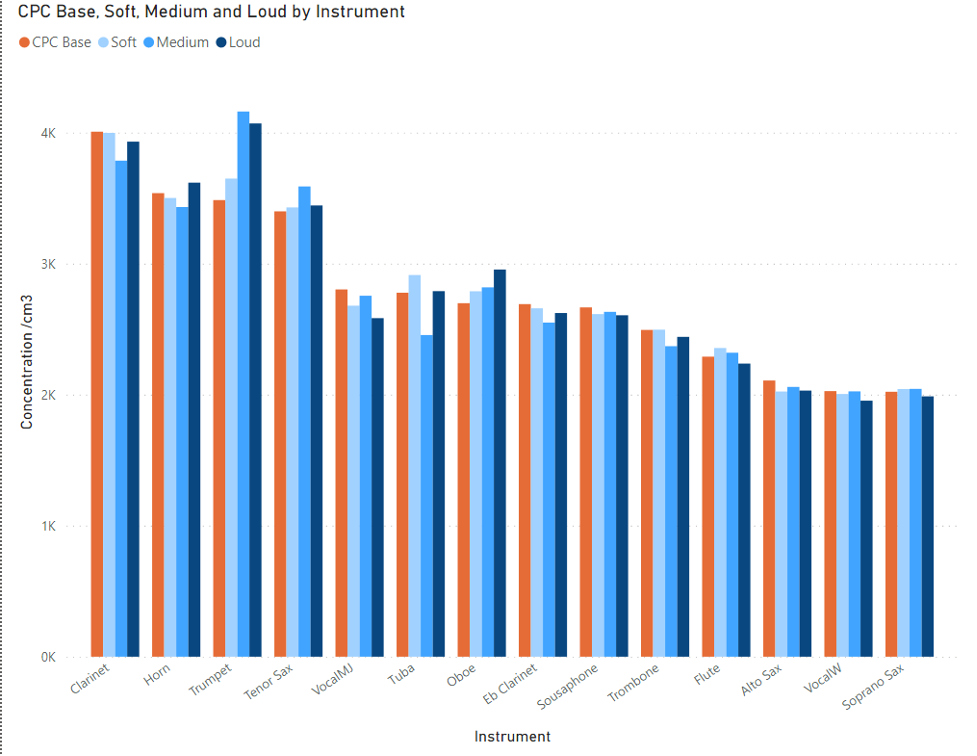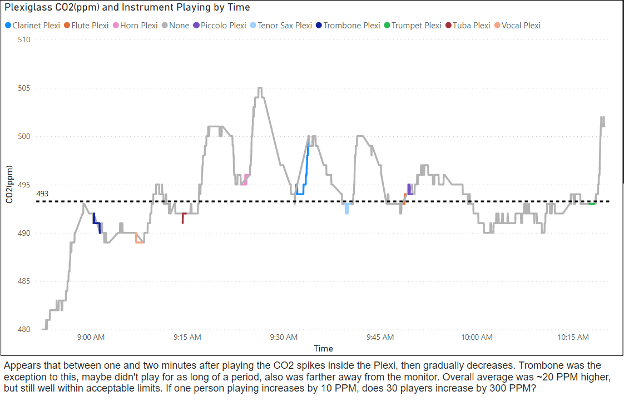The SARS-CoV-2 pandemic demonstrated a need to further understand the characteristics of airflow and aerosol particle concentrations while conducting musical activity. In this study we investigated the playing of wind instruments, singing, and breathing during percussion playing.
It is well known that SARS-CoV-2 and other viruses are transmitted through airborne transmission, particularly indoors (Stadnytski, et.al.,2020). There have been reports of transmission events where musical activity was involved (Hanner, L., 2020; Hong KongKaraoke, 2020). Studies are ongoing at the University of Colorado, University of Maryland, and Colorado State University to further understand transmission risk of micro particles during musical activities. Preliminary reports show that various instruments and singing produce aerosols which have the potential to carry viral genetic material (Miller, Srebric, 2020). At least one study (Music Making Risk, 2020) showed no increased risk for wind instruments. However, the method used was not sufficient to accurately measure the number of particles released and how far they might travel indoors, based on environmental conditions. It is possible that loudness of speech, distance between individuals, and the blowing of air through a tube may spread viral particles from infected individuals (Asadi, 2019; An Analysis of Three COVID-19 Outbreaks, 2020; Lai, 2011). More research is needed to understand the factors which contribute to aerosol spread from musical activities. This will reduce risk as much as possible not only for SARS-CoV-2, but for any airborne virus.
Fourteen participants were recruited from the West Point Band to perform this study: two vocalists (female), flute (male), oboe and English horn (female), Eb and Bb clarinets (male), Bb and bass clarinets (female), soprano and alto saxophones (female), tenor saxophone (male), Bb trumpet and bugle (female), Bb lead/jazz trumpet (male), French horn (male), trombone (male), tuba and sousaphone (male), and snare drum (male). All participants are at the pinnacle of their professional careers. Research was exempted by the United States Military Academy’s Human Research Protections Program from human research protocols, as the intent was to measure the environmental effect of musical activity rather than the individuals’ biology. The participants were provided an informed consent form to sign, indicating their willingness to volunteer and allowing the ability to withdraw at any time. Each participant was asked to speak as well as perform selections from The Official West Point March (Egner, 1927) at soft, medium, and loud dynamics. While the musicians played, the researchers measured particle concentration and airflow using two different techniques, explained below. The testing space was the music rehearsal room in Egner Hall, United States Military Academy, which is 72,600 cubic feet in volume, and has a centralized heating, ventilation, and cooling (HVAC) system. The system is optimized at 3.3 outside air changes per hour and MERV8 filtration. The HVAC system was left on in order to maintain real-world conditions.
A Kanomax model 3800 condensation particle counter was used to detect whole room aerosol concentrations from 15 nanometers to 1 micron. It was placed on a table 6 feet from the participant and 4 feet off the ground. We aimed to determine the effect of an individual participant on the ultra-fine particle concentration in the room. The device was set to take measurements every 2 seconds. Baseline background concentration was taken before each participant, and continuously through each round of testing. Normal indoor particle concentrations range from ~1000 to ~5000 per cm3.
The Schlieren video imaging setup consisted of a single-point light source, high-speed camera, razor-blade light stop, and a 24-inch aerospace-grade convex mirror provided by Danbury MissionTechnologies. This method was designed to observe air density changes from exhaled breath during musical activity. It allows for the visualization of size and direction of air current changes.
An optical gas imaging camera was used to observe exhaled carbon dioxide (CO2) during musical activity. Two CO2 monitors were placed 3 feet from the player, one in the open room, and one inside a three-sided plexiglass shield. The CO2 monitors took continuous readings throughout the testing timeframe.
All resulting measurements stayed within the normal indoor particle concentration range, with a maximum of 4563p/cm3 and a minimum of 1746 p/cm3. Four instruments had average concentrations above each individual’s initial baseline (see “CPC base” in graph below): the tenor saxophone, flute, oboe, and French horn. All other musical activity (tuba, sousaphone, alto and soprano saxophone, trumpet, Eb clarinet, Bb clarinet, trombone, snare drum, and vocalists) had average concentrations below each individual’s initial baseline. There was no significant difference observed, t(49) = 0.039, p = 0.968, between baseline concentration levels (M = 2841.885 p/cm3, SD = 678.889) and music-playing averages (M = 2834.423 p/cm3, SD = 689.537). These results indicate that a CPC cannot detect concentration changes from a single person conducting musical activity in a relatively large indoor space with an air exchange rate of three changes per hour.

Based on previous studies, we expected to observe more distinct air density changes during speaking and singing. In all participants, the warm exhaled breath was visible coming from both the mouth and nose. The directionality of the air was highly dependent on the syllables being spoken. Each subject spoke the words “West,” “Point,” and“Band.” The “P” sound generally produced a longer concentrated jet of warm air compared to other vocal sounds.

The warmer air jets were broader and carried farther during louder singing compared to soft singing or speaking, aligning with the findings of Asadi, et.al. (2019).
Air density changes were observed exiting the end of the flute. The observed flow was slower and more concentrated as compared to vocalizations. Although it is known that the player’s air is split between going through the instrument and out into the room, air density changes were not observed from around the mouth area. This can be attributed to the body heat overwhelming the video image. Similarly, we were unable to discern differences between body heat and exhaled breath from the piccolo, due to its proximity to the hands and head of the player.

The oboe and English horn were unique in our test group, in that the high amount of back pressure required to produce sound forces the player to exhale additional air in between playing sequences. This was observed with a similar visual character as other vocalizations. Airflow from the bells of both the oboe and English horn have a thin, wispy appearance as observed from other instruments.

Two participants played the Eb clarinet/Bb clarinet (male) and bass clarinet/Bb clarinet (female). We did not observe exhaled breath from around the mouth region during bass clarinet performance. Exhaled breath was observed from both the nose and mouth above the mouth piece for the Eb and Bb clarinet performances. Air density changes were observed from the bell of both Eb and Bb clarinets. Occasional air jets were observed emanating from open key holes, particularly at higher decibel volumes.


Airflow from the bell of the tenor saxophone was similar in character to the bell of other instruments and was also combined with the rising heat of the player’s right hand, which is placed towards the bottom u-joint of the instrument.

No air density turbulence was observed around the mouthpiece of the trumpet or bugle. Slow and intermediate air density changes were observed coming from the bell of both instruments. It is most likely attributed only to exhaled breath, as the hands and body of the player are sufficiently far away from the output of the trumpet/bugle.

Typical performance on the French horn often requires repeated short notes with a minimum amount of breath entering the instrument. We observed airflow from the nose of the player during this type of playing, but not during longer and continuous sound production. It was not possible to determine the difference between exhaled breath and body heat at the bell location of the French horn.

We observed slow and intermediate air density changes emanating from the bell of the trombone, which was similar to other instruments but had a wider radius. The air plume was very faint and difficult to distinguish, possibly due to the very minor change in air density.

We were unable to observe any air density changes emanating from the tuba or sousaphone bells. Some exhaled breath from the nose was observed during intermittent playing, similar to what we observed with the French horn.

During CO2 Imaging, we attempted to observe airflow patterns when the participant was standing behind a three-sided plexiglass shield; however, the shielding blocked all view of the participant and airflow.
The CO2 imaging allowed us to view the airflow that projects outward and above the mouthpiece of the flute. We did not observe this with the Schlieren technique. It is known that various amounts of the performer’s airstream is split by the flute mouthpiece in order to produce a tone. This suggests that CO2 video is a more accurate method to observe the airflow from transverse flutes.

We observed very similar airflow patterns coming from the bell of the clarinet during performance, as compared to Schlieren imaging.

The airflow patterns from the tenor saxophone were similar in both CO2 and Schlieren imaging. There was less interference from body heat in the CO2 video, which made the airflow more clearly distinguished.

CO2 imaging provided a clear picture of airflow coming from the trumpet bell. The plume moved approximately 4 inches out from the bell and then turned downwards.



We observed highly variant CO2 plumes during unmasked singing. The direction of the stream was dependent on the syllable being sung at the time and the relative volume of the tone produced.

While using a cloth two-ply mask the CO2plume was directed upwards and downwards from the mouth remaining close to the singer’s face.
Two CO2 monitors were used to measure parts per million (PPM) both inside and outside of a three-sided plexiglass shield. Average CO2 was not affected by musical activity outside the plexiglass shield. Average CO2 was 474 PPM (+- 4). One spike occurred outside of musical activity due to researchers getting close to the monitor and talking.
A pattern emerged in the CO2 readings inside the plexiglass shield. Two minutes after musical activity, CO2 spiked ~20 PPM higher and then gradually decreased, as expected. This is most likely due to the shields, which temporarily blocked excess CO2 from mixing with the ambient air. Average CO2 was 493 PPM, which is still well within established norms for indoor air quality.

Our investigation was able to add to the knowledge base around airflow and particle concentrations during musical activity. We found that one musician in a large volume space does not emit enough aerosol to be detected by a standard condensation particle counter. Other studies under controlled conditions were able to detect small amounts of aerosolized particles, which is highly dependent on the person and the musical activity (He, 2020; Miller, 2020; Parker, 2020).
Using two different methods we observed complex airflow from different wind instruments and singers. Some instruments, such as the oboe, require such a small amount of breath to activate the sound that the player must exhale the remaining air in-between musical phrases. Nose-exhalation was also observed while playing the clarinet, French horn, and tuba.
Decibel level of the sound did not affect the particle concentrations or airflow, except in the case of vocalists. Other factors such as sung consonant and vowel formation, instrument design (i.e., multiple open holes in woodwinds versus brass), and environmental fluctuations affected the results as much as the prescribed musical activity.
CO2 concentrations are a marker of ventilation speed in a space, and in our observations the levels remained low due to the large volume of space and adequate air change rate of ~3 changes per hour. CO2 took longer to dissipate when the participant was surrounded by plexiglass.
The complex nature of how musical sound is produced from singing or playing of wind and brass instruments makes field research in this area particularly difficult. Many factors, such as the biology of the musician, level of skill, and type of instrument, all contribute to the airflow and particle concentrations produced. With any airborne transmitted pathogen, the concern is of having a large group of people occupy a shared air volume. Musical performance typically requires more air volume per person than normal breathing and speaking. Designers and administrators should pay particular attention to this additional need. Music rehearsal and performance spaces should be designed and selected in part based on the air volume, outside air exchange, and filtration relative to the number of people using the space. These considerations will allow for healthy music-making spaces in the foreseeable future.
Asadi S, Wexler AS, Cappa CD, Barreda S, Bouvier NM, Ristenpart WD. (2019). Aerosol Emission and Super-emission During Human Speech Increase With Voice Loudness. Scientific Reports. 9(1): p.1-10.
Hanner, L., (2020). High SARS-CoV-2 Attack Rate Following Exposure at a Choir Practice-Skagit County, Washington, March 2020. Morbid and MortalityWeekly Report, 2020. p.69.
He, R., et.al., (2020). Aerosol Generation from Different Wind Instruments. MedRxiv preprint. doi:10.1101/2020.08.03.201678333.
Lai, K.-M., C. Bottomley, and R. McNerney, (2011). Propagation of Respiratory Aerosolsby the Vuvuzela. PloS one, 6(5).
Li, Y. et.al., (2007). How Far Droplets Can Move in Indoor Environments – Revisiting the Wells Evaporation–Falling Curve. Indoor Air, 17: p. 211-225. doi:10.1111/j.1600-0668.2006.00469.x.
Miller, S., and Srebric, J., (2020). Performing Arts Aerosol Study: A Preliminary Report.
Parker, A. et.al., (2020). Investigation into the Release of Respiratory Aerosols by Brass Instruments and Mitigation Measures with Respect to Covid-19. MedRxiv preprint. doi:10.1101/2020.07.31.20165837.
Somsen, GA, et al. (27 May 2020). Small Droplet Aerosols in Poorly Ventilated Spaces and SARS-CoV-2 Transmission. The Lancet Respiratory Medicine. sciencedirect.com/science/article/pii/S2213260020302459
Stadnytskyi, V., et.al., (2020). The Airborne Lifetime of Small Speech Droplets and Their Potential Importance in SARS-CoV-2 transmission. PNAS 117(22). doi: 10.1073/pnas.2006874117.
Music Making Risk. https://www.mh-freiburg.de/en/university/covid-19-corona/riskassessment/;accessed May 2020.
Hong Kong Karaoke. https://news.rthk.hk/rthk/en/component/k2/1518014- 20200331.htm; accessed June 2020.
An Analysis of Three COVID-19 Outbreaks. https://english.elpais.com/spanish_news/2020-06-17/an-analysis-of-three-covid-19-outbreaks-how-they-happened-and-how-they-can-be-avoided.html; accessed July 2020.